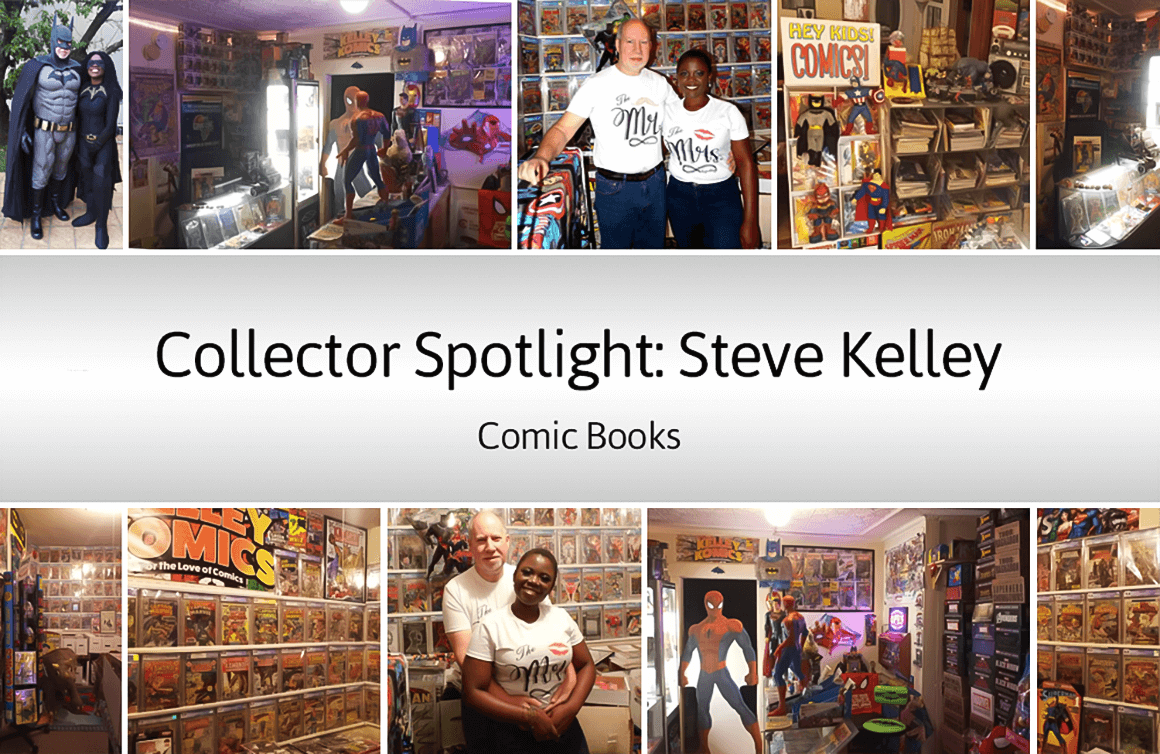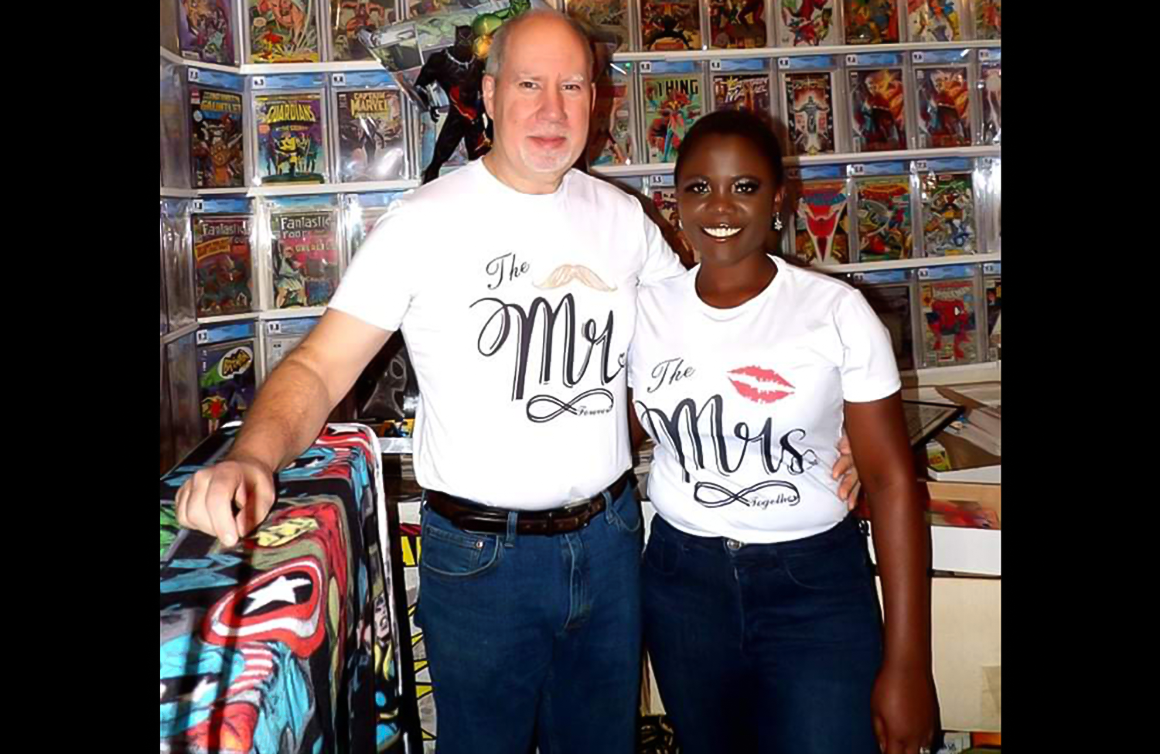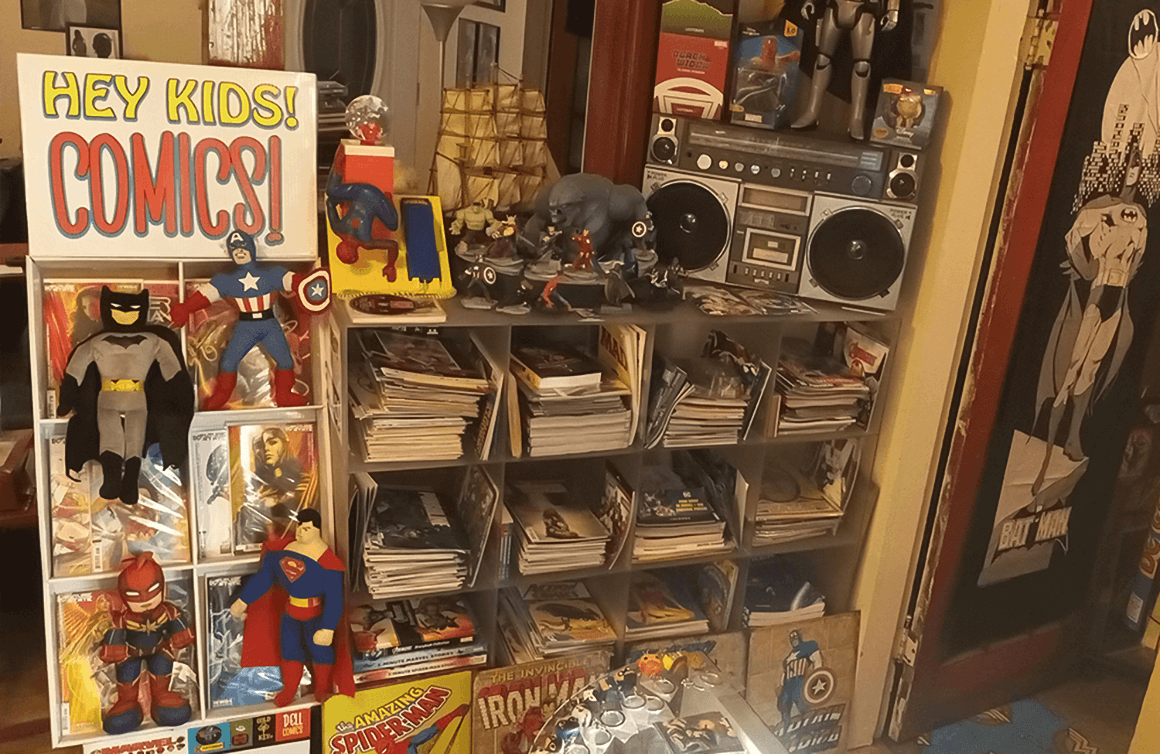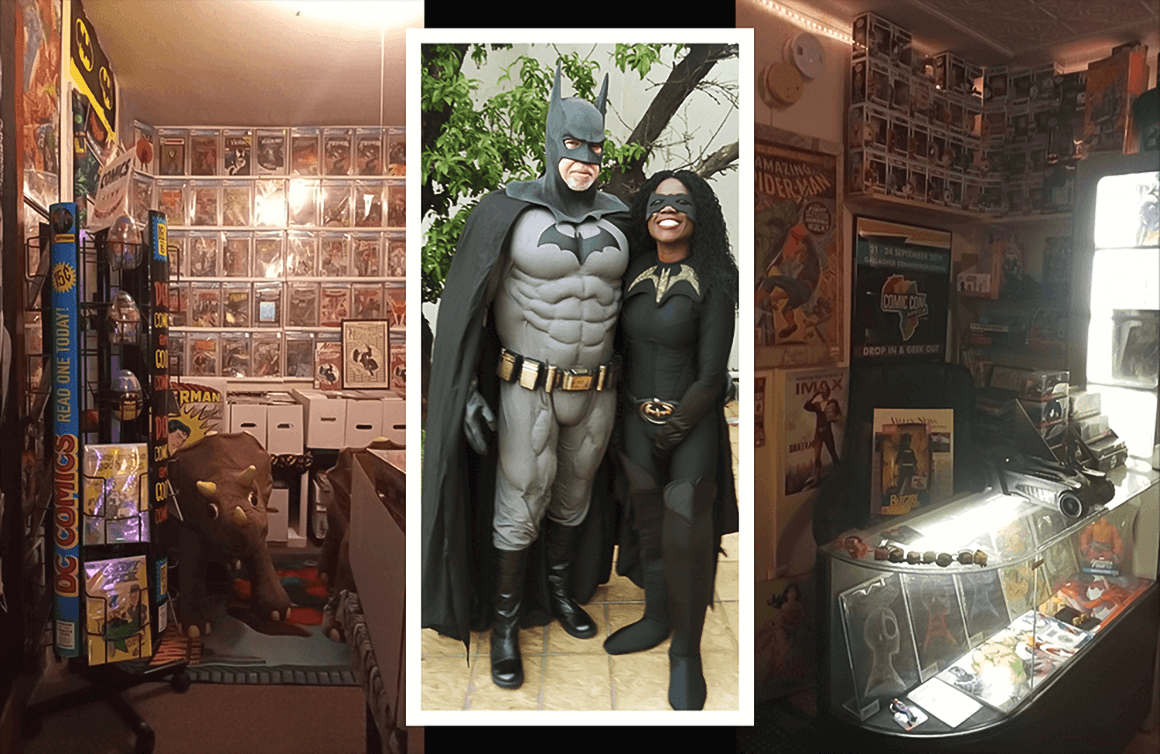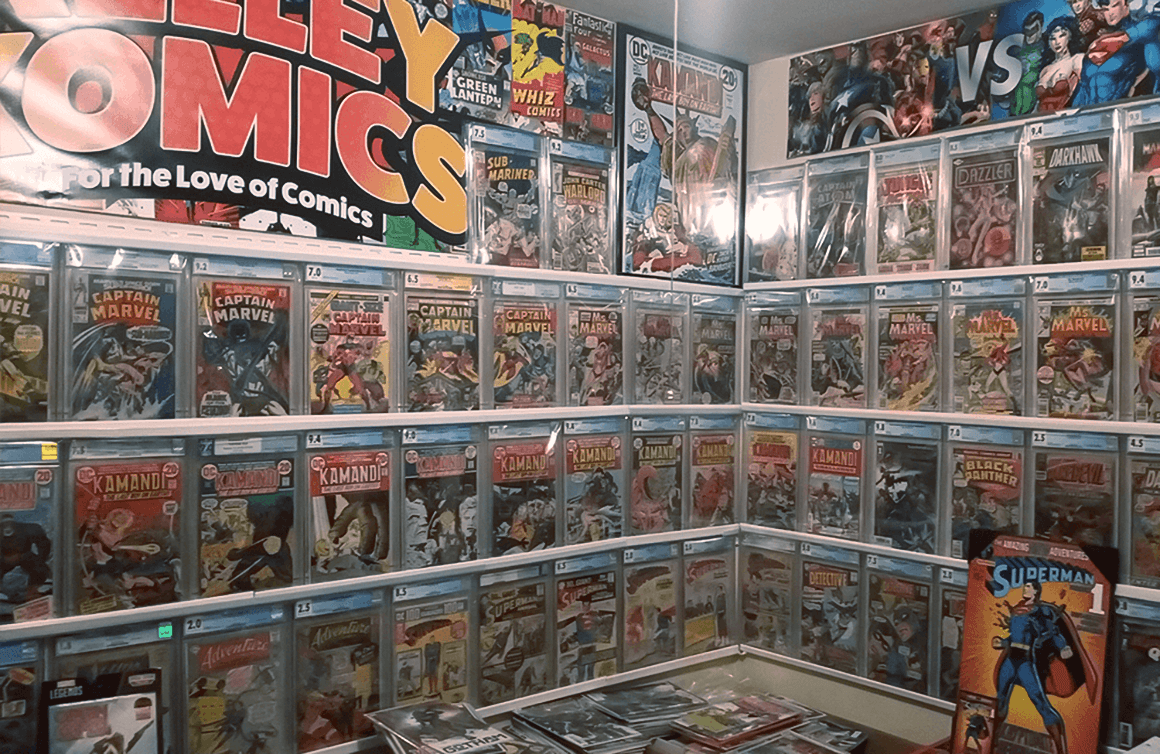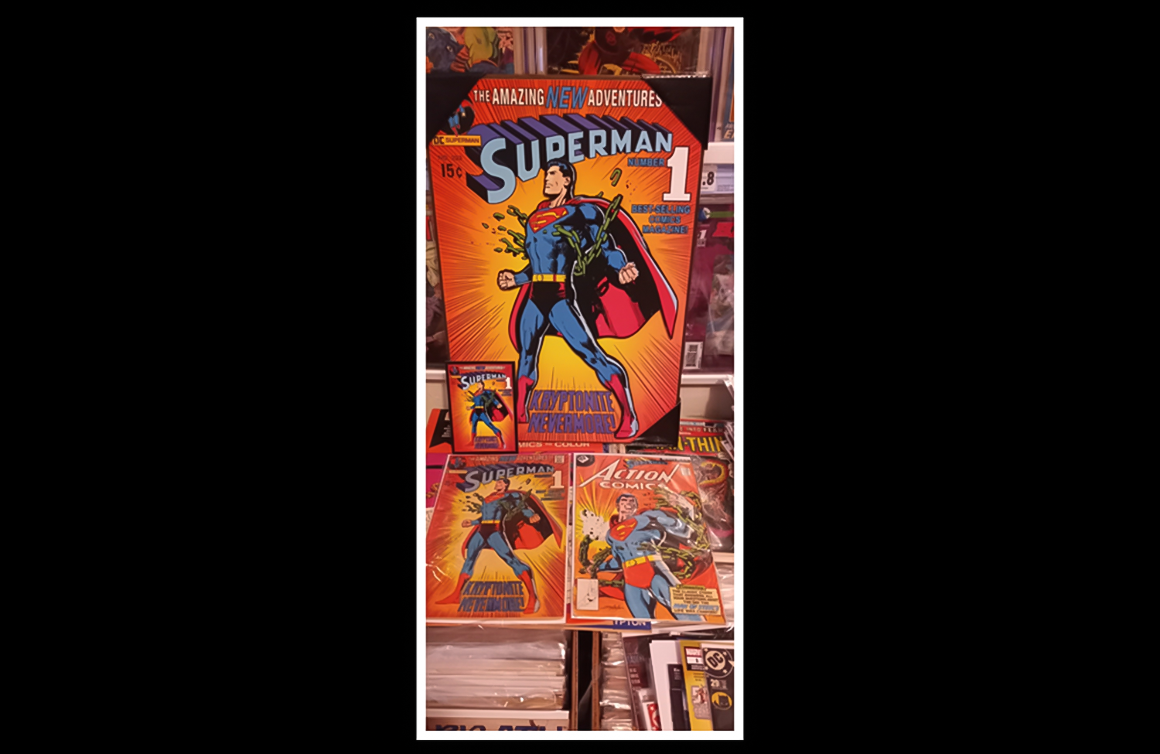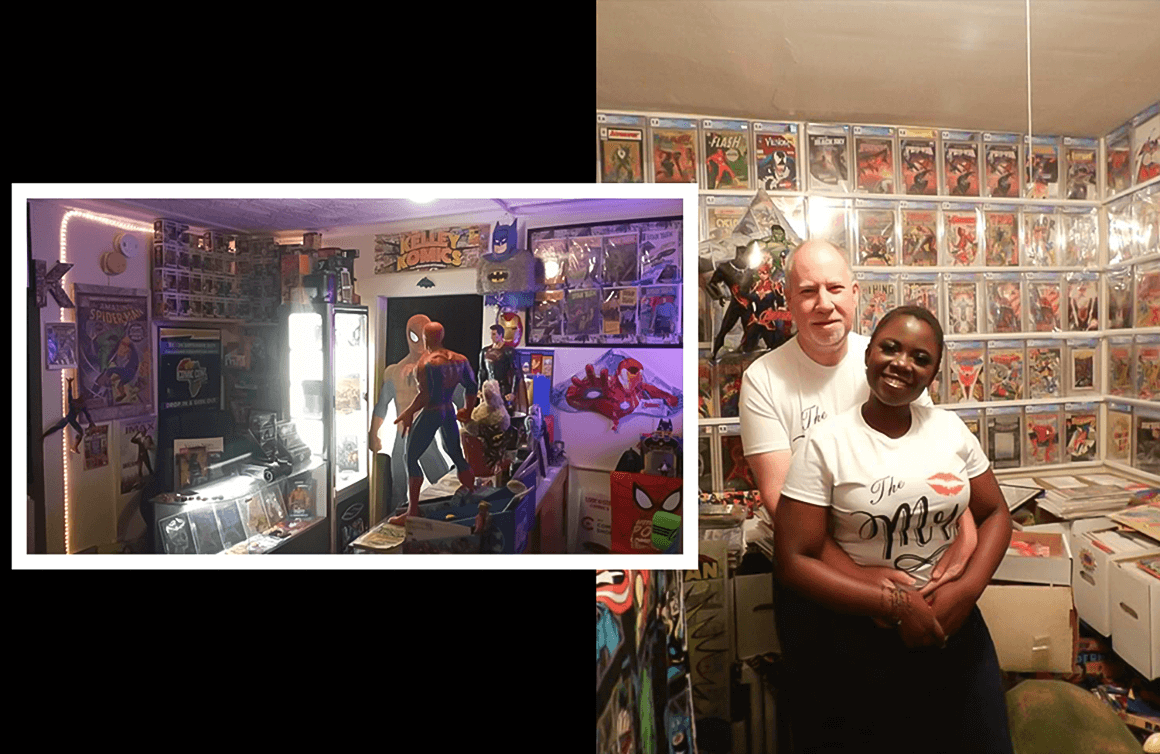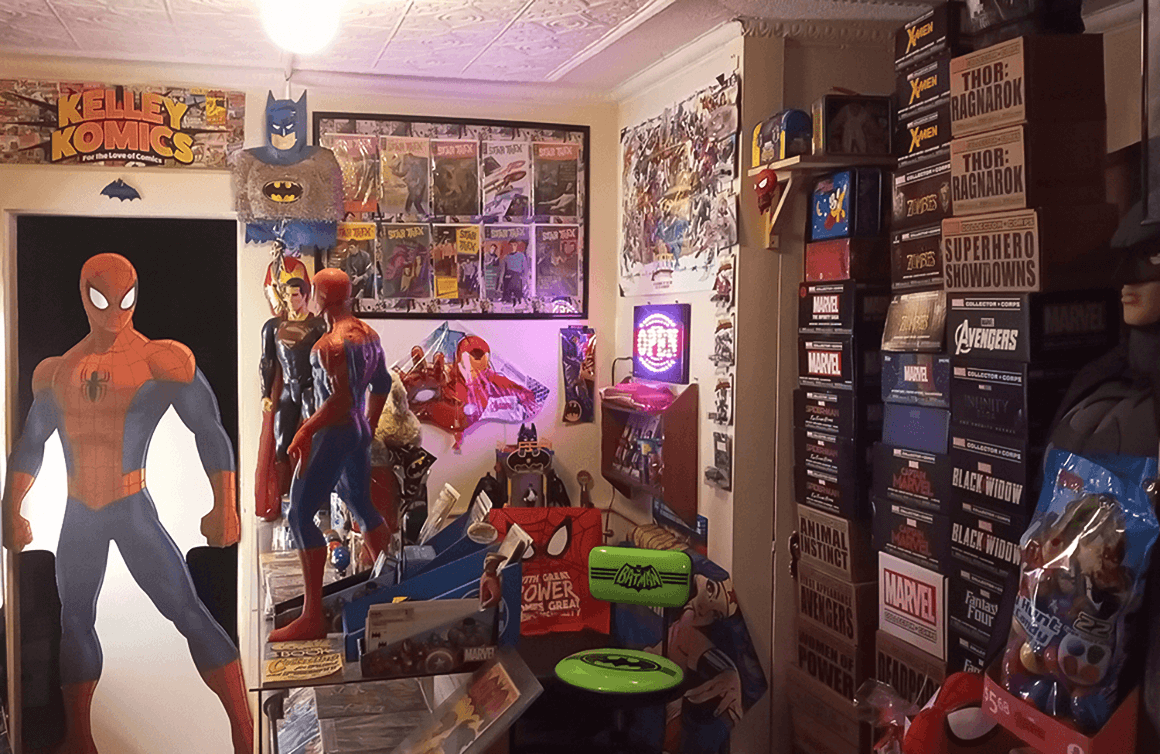How do you describe your collection?
I have over 100,000 comic books. I collect everything, but I do have my favourites.
I remember as a kid growing up in the 1970s reading a comic book called Kamandi: The Last Boy on Earth. It was created by Jack Kirby. That comic fascinated me for a couple of reasons. One was because that title came out right after the 1968 Planet of the Apes movie starring Charlton Heston. The cover of the first issue of Kamandi: The Last Boy on Earth is a play on the famous scene in Planet of the Apes where Heston rides down the beach on a horse and sees the Statue of Liberty on its side and realizes he’s in the future on Earth. The Kamandi series is based on that type of cataclysmic occurrence — Kamandi is the last human. The storyline played on similar emotions. I liked the idea of being a kid and being the only one left on the planet. Being able to explore. It’s scary but fascinating to think of that as a kid.
To go back to your question, I collect pretty much everything, I don’t focus on DC Comics or Marvel or only certain characters.
I enjoyed drawing and painting in grade school. Looking at comic book covers, I appreciated the artwork alone. I didn’t read all the comics — which would be impossible for me to do now, anyway. It’s the artwork that draws your attention. The first impression of the cover is what gets you to buy a comic. It’s always neat to flip through and just look at the unique artwork.
It’s also fun to sit down and read a variety of comics. When the 1989 Batman movie came out with Michael Keaton, I started digging through my boxes to find Batman comics that reminded me of the excitement of watching the movie. I always want to have a nice selection to revisit.
Before the Internet, we had the newspaper or those little booklets that were sold in stores for $3 that featured whatever people were selling. You could also place an ad letting people know what you were looking for. Once in a while, somebody would write or call you because they found a bunch of comics in their bedroom or attic. In doing that, and over time, my collection became vast. Now with the Internet, it’s opened up that world to a lot more people and it’s tougher to locate really good deals. You’re also competing against more people.
On the other side of the coin, the Internet and eBay have allowed me to build my collection of foreign comics. The world has opened up. I probably had one of the most impressive collections of Kamandi comics before the Internet. I’ve been able to make it even more impressive with editions from France, Italy, Mexico. When Kamandi was being published in the United States, it was also publishing in other countries but the covers may have been different. And, of course, they were in another language. That’s unique. So, all of a sudden, my collection — which was cool to begin with — is now amazing because I have all these foreign variations of the first appearances of Spider-Man and others. It’s neat to have an edition from countries like France, Russian, Mexico, and Italy.
When and why did you start your collection?
I was working at a Sears store in Lebanon, New Hampshire in the early 1980s. I met a kid named Carl who worked there part-time. He was a big comic book collector. I was into reading comic books then but not really into collecting them. We became friends and started hanging out together. Carl went to Keene State College and also worked part-time at a Keene comic book store.
When we weren’t working, we’d go to comic book stores together. I was already a collector of other things so I instantly go into collecting comics as well. My mother jokes, “That’s my son, always go big or go home,” so that’s what I did. I started collecting a comic book here and there but I wanted to establish a good collection from the start. I asked comic book stores if they were ever approached by people looking to sell their collections. A lot of times resellers will buy a collection to put into their inventory to sell but they want to buy them inexpensively so a collector may not want to sell to a reseller. A private sale can get a collector more money.
A fellow had gone into one of the comic book stores in Keene with a collection that had belonged to his father who passed away a few years prior. The collection had been stored in the attic and some of the boxes of comics were next to a damp wall and had mildewed. Some of them weren’t in very good shape. The comic book store passed on the sale but they gave me his number in case I was interested. I called the guy and we met at his house. Sure enough, there were boxes that weren’t in very good shape and I wasn’t that interested. Then I looked a little further into the attic. There were probably about 10 or 12 long boxes, each holding about 300 comics. Those boxes were undamaged.
I went over and flipped through some of the comics. There were some — remember this is in the 1980s — that were from the 1970s. They were only 5 or 10 years old at that time. Some of the titles were fairly common but some piqued my interest — a couple of Golden Age comics from the 1950s and earlier. The earlier Superman comics from the late 1930s were there.
I made him an offer of a couple of hundred dollars. He was happy to get some money for them and to get them out of the attic. It took me a couple of trips to load them into my car — I had a Fox-body Mustang at the time, it was a small vehicle. I came back with my dad’s pick-up truck a couple of days later to gather the rest. I stuck the comic books in a room when I got home and didn’t think much about them for a while.
Carl and I got into more comic books as time went on. I went back to that collection from the attic and discovered I had hit the motherload. There were some holy grail comics there — the ones that everybody wants to own that feature the first appearance of a character. They were in fairly good shape. You could buy a house with their worth today.
Over the course of the 30 or 40 years, I’ve moved, been married, then divorced. I’ve tried to hang on to the comics, my Star Trek collection, and other collectibles. Some have been lost or stolen.
Right before the pandemic, I was interviewed about my Star Trek collection for a Netflix series called The Toys That Made Us. One of the things you have to understand about collecting is the idea of cross-collecting. That means that people who collect different things than you may collect a common object. For example, there are Star Trek comics that will appeal to a Star Trek collector whose collection isn’t based on comic books. When you go out into the collecting world to bid on things, you might be bidding against someone who fits into the cross-collecting category. People watched that episode of The Toys That Made Us and saw that my Star Trek collection included the first Star Trek Gold Key comics from the late 1960s and 1970s. The comics were loosely based on the show. They had original stories but didn’t even have the same colour uniforms. It makes it more unique because of the silliness of things like having flames come out of the shuttlebay.
Somebody noticed that I had a nice comic book collection and I was contacted by another show that wanted to do a story about the collection. The pandemic hit so that didn’t happen but during that process, I played around with my display and ultimately part of my house now looks like a comic book store. My wife, Leticia, calls it the Wonder Room.
How do you display and store your collection?
In the early days of comic collecting, there weren’t many options to safely store comics. Today we have bagging and boarding using pre-cut acid-free card stock and clear bags. The cardboard goes inside the bag, followed by the comic book. This method holds the comics stiff so they don’t get bent or dinged and they fit nicely into the long boxes. Comics can be stored like this for quite a while before the bags might need to be swapped out because they can deteriorate over time.
You also have to be careful with light, from any source, because it will fade the artwork. We’ve all seen items that sat in a window for a long time — the colour fades.
The other answer to the question of storage are companies such as CGC, CBCS, and PGX . They are comic grading companies that offer a service where they’ll preserve comics in a solid plastic slab. It’s similar to a picture frame. The process involves grading a comic, sealing it in a bag, then encasing it in a plastic slab. It preserves the comic book in its graded condition. This does three things: it guarantees the condition of the comic, it allows for more secure storage of the comic, and it makes for a nicer display.
In the process of bringing things out for the show, I rediscovered a lot of comics that I’d forgotten about because I hadn’t really catalogued them. For quite some time, my focus was on the Star Trek collection and I authored a book on the subject. It was neat to set Star Trek aside and get back into comics.
In doing that, I found some holy grails, such as Action Comics #1 from 1938 which features the first appearance of Superman. When you share these things on Facebook you catch people’s attention and some of those people run comic book events. I’ve been invited to be a guest speaker and talk about collecting and how to obtain some of the more valuable titles. Those are fun to do. You don’t want too much attention, though, because you don’t want your collection to become a target for thieves.
What do you consider to be the Holy Grail of your collection?
In comic collecting, there are usually two holy grails. There is the overall grail — the title that everybody recognizes as being the one to own. It’s usually based on value. Most people agree that Action Comics #1 is the holy grail — the first appearance of Superman. That has been true for many years. However, we did witness recently a very nice copy of Marvel Comics #1 published in 1939 selling for $2.4 million at auction. This rare comic introduced the first Marvel characters — including the Human Torch and the Sub-Mariner — and created the start of the Marvel Universe as we know it today. I own a raw copy of this iconic and rare comic though not nearly as nice as the one that just sold at auction. The grails are often the first-appearances comics: the first appearance of Batman, Spider-Man, Supergirl, Captain America, Iron Man.
The other grails are personal — the first comic you bought as a child, a title you wanted to purchase but couldn’t, or the one your parents sold at a garage sale. That might be the first printing of the Teenage Mutant Ninja Turtles for some collectors.
I have many of the vintage holy grails at this point. Now I look to find something cool to add to my collection. When I go to conventions with Leticia, she looks around for interesting things for me. There’s an excitement about going to events and trying to find something cool. I’m looking for things to fill in the gaps or seeking a better quality of a title I already own.
Leticia is from Zambia and comics weren’t a big thing in her life. It fascinated her to learn more about my world of Star Trek and comic books. She went to her first comic book event recently. We were invited by DC Comics to an advance viewing of The Batman movie. She just read Batman: The Long Halloween — which is the storyline on which The Batman is based. It was fun to be in the theatre with other people who had been invited, to have the cast come on to the screen to thank everyone for being there. It’s nice to be part of the comic world together and to see it from her point of view.
Leticia worked in South Africa in 2019. I flew there to spend some time with her and brought my Batman suit and picked up a Batgirl suit for her. We visited the Nelson Mandela Children’s Hospital in our costumes. It was a very special visit. I also proposed to her on that trip.
What advice would you give to someone interested in starting a comic book collection?
Collect what you enjoy. Don’t be forced into thinking you have to collect specific titles or characters.
Don’t be intimidated by other people’s collections. I see this in Facebook groups all the time. A new collector will join the group and be very proud of their collection. Then they see the massive collections of others and kind of lose their appetite for it. Don’t be intimidated by what other people have, be proud of what you have and what you enjoy.
I have an interesting story about a Facebook group. One day, people were sharing their stories about trades they had done. People had traded comics for tools and things like that. Someone then asked about what we would trade a comic for — what would we want in return. I shared that I had recently sold my Jeep Wrangler and regretted it. I wanted to get another one and had been starting to look. The prices had skyrocketed and I didn’t think I would get one again. I jokingly said that I would trade a comic in my collection for a Wrangler if anybody wanted to do that. Out of the woodwork, people came forward. I had offers to trade motorcycles, Corvettes, and all sorts of stuff. I narrowed it down to three people who had a Wrangler they would consider trading. One was in Boston, one in Nashua, and there was one in Connecticut. The one in Boston wasn’t as nice as I wanted. The guy in Nashua ended up selling the vehicle. I did a deal with the guy in Connecticut. I traded him a Captain Marvel #1 for his Jeep Wrangler. The Wrangler was worth about $20,000 — more than I thought the comic was worth. He no longer needed the vehicle but wasn’t getting the right offer when he put it up for sale. We just happened to both be in the same place at the same time.
My advice: it’s your collection. It doesn’t matter how big or how small it is. Enjoy it.
Connect with Steve other comic book collectors on his Facebook group.
Drop us a line to let us know about your collection of vintage toys and/or games. We just may feature your collection!

